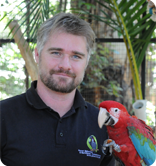Keeping Parrots Together or By Themselves

How important is it for parrots to be kept together or by themselves? I have owned several parrots over the years and found that some get along great, whereas other do not. I am convinced that a few of them consider themselves to be human and prefer our company to those other funny looking things with feathers. Would appreciate your advice.

My personal philosophy is that it is extremely important for parrots to share their environment with other parrots, if the social enrichment and companionship of humans is inconsistent and highly variable. Apart from that classic exception to just about every psittacine rule, the Kakapo, the two most unnatural situations that many captive parrots seem to struggle to adapt to are lack of flight, and lack of opportunities for stimulation and socialisation with other parrots. Along with a lack of foraging opportunity, those deficiencies are often the key contributors to the development of many behavioural problems we deal with in companion parrots.
I have travelled throughout Australia, Asia and Central America observing parrots in the wild. It is an extreme rarity to ever observe a parrot without either a bonded partner, small family group, or a seasonal flock close by. In the rare circumstances when parrots are observed on their own in the wild there is a reason for this. It is always a temporary situation and one that, among other things, potentially leaves them vulnerable to predation. So much of the behavioural ecology of a wild parrot is intimately linked to having evolved and been naturally selected as a social, flocking creature that it really does confound me that humans consider it acceptable to keep them on their own and wonder why problems arise as a direct or indirect result.
We also need to have realistic expectations when it comes to species, and even individual, compatibility. The common misconception is that we look at `parrots' as a single organism that comes in many different shapes, sizes and colours. The reality is that we're looking at 350+ different species, each offering a suite of different behavioural characteristics that may not immediately cater for compatibility with other species of significantly different taxa. There are however, plenty of indications that much of the social behaviour we observe is learned, rather than innate. This sets up opportunities for mixed species groupings to work when individuals of different species groups are raised around each other in captivity. Parrots are also socially adaptable, so in the absence of their own species, it is not uncommon for an individual to develop relationships with other parrots of different species. This gravitation towards developing a pair bond, even outside of a conspecific, is indeed the basic characteristic that results in parrots bonding to humans and endearing themselves to us.
Of course, there are many parrots out there who are kept on their own and perhaps, all observations indicate they are doing fine. I am inclined to suggest that in those cases, the interaction schedule with their human owners is high and they live in a great and stimulating environment that caters for their needs well. I would also suggest that these are the exceptions, rather than the rule, when it comes to parrots on their own. Indeed, in such cases, the parrot isn’t really on its `own’ - the humans are with them most of the time. Over the years, I have developed an extensive amount of first hand experience observing the behavioural results of parrots making a transition from an isolated life to one that offers exposure to other psittacines. Everything from flocking of mixed species in large zoo exhibits as a keeper to simply housing pet parrots in seperate enclsures near each other in a home enrvironment. Given an appropriate set of conditions, this transition almost always results in an enhanced degree of behavioural activity, on many levels. Of course, there are many considerations that need to be made to successfully achieve such a transition. Some parrots kept in isolation from other parrots for many years may lack the socialisation skills necessary to avoid conflict. I have one such bird, and although we are yet to find a parrot that he will tolerate co-habitation with in the same enclosure, you only need to observe the degree to which he interacts vocally with the other parrots in our environment, and how he responds to the subtleties of their behaviours, to know that there is a really intense interaction dynamic at play, and one that I am certain he is benefiting from. Species compatibility, housing and enclosure design, access to food and perching resources in mixed flock enclosures and monitoring incompatibility stress are all essential considerations for the welfare of parrots kept with or near other parrots.
Just finally -- rather than thinking your parrots consider themselves `human', perhaps is it more likely that they indeed know they're birds and look at us as funny looking birds without feathers? Hmm. I guess we'll never know...
Kind Regards from `Down Under'
Jim McKendry
Parrot Behaviour & Enrichment Consultations
http://www.pbec.com.au

































